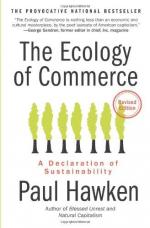|
This section contains 486 words (approx. 2 pages at 400 words per page) |

|
Chapter 3, The Creation of Waste Summary and Analysis
Waste is created by the process of industrialization. Wastes remain in the environment and the environment's ability to deal with waste is limited. The myths created only propagate the problem. Transferring wastes to a different environment, like a landfill, does not solve the problem. The problem is not the disposal of the wastes; it is the actual creation of the waste that is the problem. They do not mimic nature. Wastes, in nature, are food for other forms of life. There is basically no waste in nature, unlike industries that are linear systems that use up resources.
Many forms of toxic wastes are due to disposable diapers and polystyrene. These are organochlorine compounds that produce dioxins, which release chlorine gas. These compounds take hundreds and thousands of years to decompose and cannot be...
(read more from the Chapter 3, The Creation of Waste Summary)
|
This section contains 486 words (approx. 2 pages at 400 words per page) |

|




